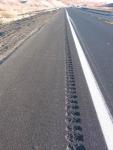As you may already know, the City has been plowing the Martin Goodman Trail this winter. A few weeks ago I took my bike down and discovered a peaceful east-west winter bike route where I didn't have to worry about sliding into a streetcar track or get run over. Bliss. This video and G&M article by Christopher Shulgan explains how the City got to plowing it and gets feedback from runners and cyclists. It's "revolutionized" the lives of runners and cyclists alike, according to Shulgan.
How did this happen? City hall has grown accustomed to hearing the suggestion that it clear snow from various paths around the city. The previous time that municipal government examined clearing snow from the trail, in 2004, the proposal was rejected because the city said it didn't have the money.
Then came last winter's near-record snowfalls. The city began a wide-ranging review of its snow-clearing practices. And an increasingly effective cycling lobby began pushing, via the Toronto Cycling Committee, for a snow-free Martin Goodman Trail.
For example, Tammy Thorne, a bulldog on the cycling committee and the editor of the cycling-lifestyle magazine Dandyhorse, buttonholed Mayor David Miller at last summer's Jane Jacobs Awards and gave her own pitch for clearing snow from the lakeshore trail. "He appeared in favour of it," she said.
At some point, Mr. Miller turned to Gary Welsh, general manager of transportation services, the department that handles snow-clearing, and challenged him to clear snow from at least one of the city's major east-west bike paths.
Bet you didn't know it may cost up to $200,000 by the end of this record winter. But isn't it worth it? Go use it and send a Valentine's card to the Mayor.
Don't let it get to your head Councillor Heaps and Mayor Miller, lest we all have to put up with yet more complaints from cyclists about the unusable bike lanes.
Update: We've now linked to Chris' updated video.

